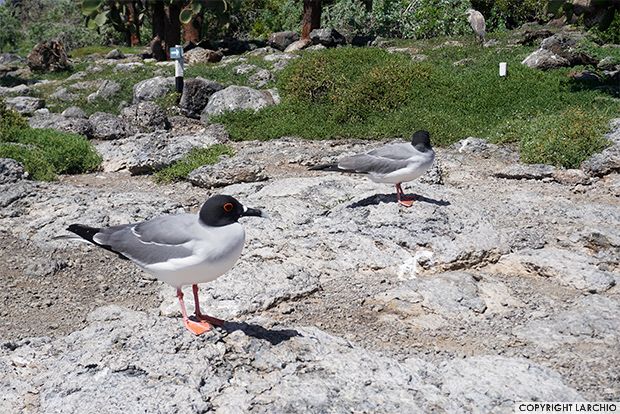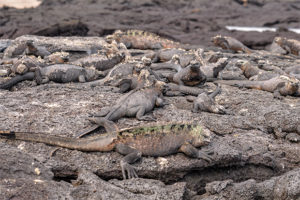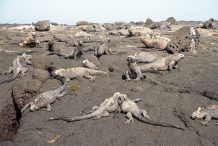Travel Packages to Galapagos Islands
We’re the top Galapagos local tour operator. Travel with trust!. Travel Packages to Galapagos Islands.
The Galapagos Island chain, situated approximately 600 miles west from the continent of South America, is possibly the absolute best destination to witness evolution in all of its natural glory.
Named, in Spanish, after the animal that is without any doubt the most well-known of the island chain: The Galapagos Tortoise; the Galapagos boasts many clusters of minor dainty islands which are created of undersea volcanoes eruptions.
Situated directly on the equator, the Galapagos gains all the bonuses of such a global placement in that the 16 islands have bright and sunny weather conditions all year long! If that wasn’t sufficient they are at the crossroads for two vitally important trade winds: The North East winds (coming from North & Central America) and the South East winds (from South America). These winds are likely exactly what initiated the influx of sustainable life around the island chain – and are thought to have been the reason for the huge woods spreading over the higher slopes of the islands.
These island of intense natural splendor have generated the evolution of various diverse, and really unusual, environments that have in turn made it possible for the local wildlife, both flora and fauna as well, to evolve in such a way that to put it simply has many researchers stunned.
The rest of the Galapagos chain is also a place of unique, not forgetting quite beautiful wildlife.
Galapagos Islands Weather Average
Thanks to the confluence of cool water currents from the west, the Galapagos archipelago has an unusual dry and moderate climate for the tropics and is commonly classified as sub-tropical. This makes Galapagos vacation a year-round family vacation alternative. Galapagos weather is considered equatorial, refrigerated because of the Humboldt Current, and is also known by two principal conditions:
The hot, wet period
Late December to June is definitely the warm and wet season, with March and April typically actually being the hottest and wettest months. Close to December, the winds go down and the climatic equator (located north of the geographic equator) shifts south toward the Galapagos, triggering the westward-flowing current to slow, reducing the upwelling and letting warmer water coming from the Panama Current to bathe archipelago. Galapagos weather conditions are known by rain clouds which develop when the inversion layer breaks down, along with the air warms and goes up, causing daily afternoon showers. Even in this period; but, the low levels get limited rain.
The colder, dry season
This season, also known as the “garua season” runs from the later part of June to December, when it is dry and cool with an increase of cloudier skies and periodic drizzle or mist (garua) through the day. August is the colder month. In this dry season, Galapagos weather conditions are pleasurable, water temperatures are lower and there are typically clouds over the larger levels. Line of sight is usually lower in the water due to plankton bloom, but this combination of circumstances produces a lot more action in the water and food is abounding. Due to the fact Galapagos climate is not very hot during this period, it is also the reproduction interval for several sea birds and shore birds, marine iguanas, sea lions and fur seals.
El Niño and La Niña Events
El Niño is a dysfunction of the oceanic and atmospheric systems of the coastline of Latin America that triggers atypically hot water temperatures, a change in the course of the winds, modifications in currents, and considerably more rainfall. The higher rainfall results in the harmful inundating on the Pacific, and, at the same time, creating drought in the western Pacific, as far as Australia. This particular phenomenon is anticipated by simply checking a change in temperature on the top of the ocean, wind factors, and currents close to Ecuador and Peru.

The Islands are famous for their distinctive vegetation and vast number of native species present nowhere else in the world. These include; reddish and blue-footed boobies, frigate birds, giant colorful tortoises, flamingos in addition to sea and marine iguanas.
You can also complement your holiday experience with some additional nights at Galapagos resorts to enjoy the calmness and tranquility of these enchanted islands. Ahead or after your Galapagos cruise, you are able to reserve one of our preferred hotels in the main Islands of the Archipelago. We’ve selected for you some of the best hotels in the Galapagos. Each hotel offers exceptional services, a friendly atmosphere, and comfortable rooms for relaxation and rest.
In addition, we have an attractive alternate to unite the experience, as like the cruises, we’ve got different price ranges based on your needs. We provide the combined hotel and cruise packages to the Galapagos Islands. Our joint tours are the perfect way to see all of the main allure of the Galapagos, and revel in a stay in some great accommodations. Each of tours offers trips in the Islands in which an English-speaking guides will come together to pass along advice and answer all your queries. We provide several tours selected for you so as to fit all of your specific requirements.
Each of these Galapagos’ official guest sites has something special to offer, but travelers will be able to experience the greatest hits — sea lions, marine iguanas, lava lizards, endemic birds — about the majority of islands. Listed below are a few of the most well-known spots.
Santa Cruz includes the Galapagos’ most populous “city,” Puerto Ayora, and will be the island chain’s main tourism hub. The island offers people the only opportunity to experience the Galapagos’ inside high-lands, among a couple places to see giant tortoises in their natural habitat. The Charles Darwin research center, a visit to which will be included on every travel, is also located here.
South Plaza encompasses less than one-tenth of a mile in area and is one of the Galapagos’ smallest visitor websites. Nevertheless, the tiny island, which was formed by volcanic uplift, makes a strong impression with its color-changing ground vegetation, sea lions and colony of Galapagos land iguanas. The successful male iguanas could be seen standing guard in front of a cactus tree, waiting patiently to offer a hungry female using a part of prickly fruit.
Rabida: makes a bold statement when you arrive during its iron-rich red shore. Just inland is a brackish lagoon where people often visit flamingos, heads plunged underwater to spoon up crustaceans and algae with their bowl-like beaks.
Fernandina, the Galapagos’ youngest and westernmost island is famous for its not-infrequent volcanic eruptions, the latest of which was in 2009. It is situated at the locus of the “hot spot” which created, and is still forming and creating, the Galapagos. As visitors step across lava flows and around the huge population of land iguanas, they develop a first-hand comprehension of the geological origins of those islands.
Floreana is home of the Galapagos’ famous barrel-mailbox at Post Office Bay. For centuries, those visiting the famed Ecuadorian isles relied upon the unspoken responsibility of pirates and whalers to acquire letters to a planned destination. A mariner would render a dispatch, then select through the stack for missives he could send (travel schedule allowing). The tradition continues today; cruise passengers visiting the website may leave and take postcards from a (modern) barrel. Floreana is home to the Galapagos’ famous barrel-mailbox in Post Office Bay. For centuries, those seeing the famed Ecuadorian isles relied upon the unspoken responsibility of pirates and whalers to Puerto Villamil and Nearby Regions – Isabela Island Cruises take in a variety of interesting points around the massive island. Puerto Villamil is a small port in the south east of the island, and it’s home to the clear majority of the island’s inhabitants. It’s possible to take pleasure in the fishing-community vibe, sample tasty freshly caught seafood, participate with all the merry kids, shop for souvenirs from the colorful stores, and respect the islets that dot the shore. Stroll along the boardwalk, resulting through mangroves, and watch flamingos, gallinules, whimbrels, and much more. The Tortoise Breeding Center sits at the end of the boardwalk, helping conserve sea tortoises. The harbor is frequently full of little luxury yachts and other sailing vessels, many of which take passengers on exciting Galapagos cruises.
Isabela Island Cruises enable guests to find the natural beauty of the largest island of the Galapagos. Straddling the Equator, Isabela Island is in the western portion of the Galapagos archipelago, close to the volcanic Galapagos hotspot that created the island collection. A lesser-visited area, it is also one of the most varied, which is no mean accomplishment in an area that’s already known for being among the most diverse areas on Earth.
Galapagos Animals
The Galapagos penguin is the only to be found in the northern hemisphere and to strain in the tropics.
A Galapagos tortoise can weigh up to 595lb (270kg) with a carapace length of 4ft (1.2m) and outlive most people.
The endemic Galapagos fur sea lions would be the smallest one of the world’s seven species of fur sea lions
The Galapagos Marine Iguana is the only marine lizard to exist on the planet.
The Galapagos Islands are home to the world’s largest cormorant and the only one unable to fly.
Galapagos has among the world’s rarest ecosystems in which the herbivores on top of the food chain are reptiles.
Galapagos Swallow-tailed gulls are the only gulls in the world to feed at night time.
The Galapagos boasts the world’s biggest and only red-footed booby colony.
The Galapagos is one of those few regions of the planet where turtles are still a frequent sight.
In 30cm in length and using a large set of venomous jaws, the endemic centipede (Scolopendra galapagoensis) is one of the Islands’ most feared animals.
A lichen survey in June 2010 from the Charles Darwin Foundation discovered over 60 brand new species in the Galapagos with an estimated ten species new to science.
GALAPAGOS CRUISES 2024
NEMO 3
| DEPARTURES | ITINERARY | AVAILABLE CABINS | SPACES | |
|---|---|---|---|---|
| There aren't available dates for the selected dates |
















